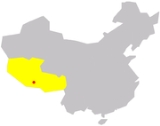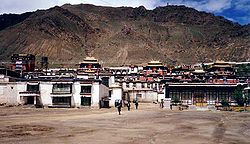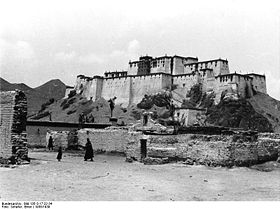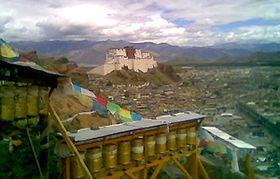
Shigatse
Encyclopedia
Shigatse is a county-level city
and the second largest city in Tibet Autonomous Region
(TAR), People's Republic of China, with a population of 92000, about 250 km (155.3 mi) southwest of Lhasa
and 90 km (55.9 mi) northwest of Gyantse
. It is the administrative centre of the modern Xigazê Prefecture
, a region of the TAR.
The city is located at an altitude of 3840 metres (12,598.4 ft) at the confluence of the Yarlung Zangbo (aka Brahmaputra) river and the Nyang River
(Nyanchue) in west Tibet and was the ancient capital of Ü-Tsang province
. It is also the name of the surrounding county.
 In the 19th century the "Tashi" or Panchen Lama
In the 19th century the "Tashi" or Panchen Lama
had temporal power over Tashilhunpo Monastery and three small districts, though not over the town of Shigatse itself, which was administered by two Dzongpön (Prefects) appointed from Lhasa
. Before military conflict between the PRC's People's Liberation Army
and the Central Tibetan Administration
, the Tibetan territory was divided into 53 prefecture districts called Dzongs.
There were two Dzongpöns for every Dzong—a lama (Tse-dung) and a layman. They were entrusted with both civil and military powers and are equal in all respects, though subordinate to the generals and the Chinese Amban
in military matters. However, there were only one or two Ambans representing the Chinese emperor residing in Lhasa, directing a little garrison
, and their power installed since 1728, progressively declined to end-up as observer at the eve of their expulsion in 1912 by the 13th Dalai Lama. In 1952, shortly after the PRC sent forces to the region, Shigatse had a population of perhaps 12,000 people, making it the second largest city in Tibet.
, located in the south central part of the Tibet Autonomous Region. The city itself lies at an elevation of around 3840 metres (12,598.4 ft), and within its administrative area there are 5 peaks taller than 5500 metres (18,044.6 ft). The city's administrative area ranges in latitude from 29° 07' to 29° 09' N and in longitude from 88° 03' to 89° 08' E.
Shigatse has a monsoon
-influenced, alpine version of a humid continental climate
(Köppen
Dwb), with frosty, very dry winters and warm, wet summers. Temperatures are relatively moderate for the Tibetan Plateau
, as the annual mean temperature is 6.3 °C (43.3 °F). Barely any precipitation falls from November to March, when differences between day and night
can frequently exceed 20 C-change. Nearly two-thirds of the annual rainfall occurs in July and August alone. Sunshine is abundant year-round, totalling 3248 hours annually.
and 10 townships.
Monastery, founded in 1447 by Gendun Drup, the First Dalai Lama
. It is the traditional seat of the Panchen Lama
s. Until the Chinese arrived in the 1950s, the "Tashi" or Panchen Lama had temporal power over three small districts, though not over the town of Shigatse itself, which was administered by a dzongpön (general) appointed from Lhasa. In the 2nd week of the 5th lunar month (around June/July), Tashilhunpo Monastery is the scene of a 3-day festival and a huge thangka
is displayed.

 The imposing castle, Samdrubtse Dzong or "Shigatse Dzong", was probably built in the 15th century. It looked something like a smaller version of the Potala, and had turret-like fortifications at the ends and a central Red Palace. It used to be the seat of the kings of Ü-Tsang
The imposing castle, Samdrubtse Dzong or "Shigatse Dzong", was probably built in the 15th century. It looked something like a smaller version of the Potala, and had turret-like fortifications at the ends and a central Red Palace. It used to be the seat of the kings of Ü-Tsang
and the capital of the province of Ü-Tsang or Tsang.
The castle was totally dismantled, rock by rock, by hundreds of Tibetans at the instigation of the Chinese in 1961. Between 2005 and 2007, the building was reconstructed, financed by donations from Shanghai. The basis of the reconstruction were old photos, yet reconstruction was executed in cement/concrete. Afterwards, the outside was to be wainscotted with natural stones. The dzong which, in the 17th century, clearly was taken as example when the Potala palace was constructed in Lhasa, is set to become a museum for Tibetan culture
.
Nearby attractions include:
China National Highway 318
County-level city
A county-level city is a county-level administrative division of mainland China. County-level cities are usually governed by prefecture-level divisions, but a few are governed directly by province-level divisions....
and the second largest city in Tibet Autonomous Region
Tibet Autonomous Region
The Tibet Autonomous Region , Tibet or Xizang for short, also called the Xizang Autonomous Region is a province-level autonomous region of the People's Republic of China , created in 1965....
(TAR), People's Republic of China, with a population of 92000, about 250 km (155.3 mi) southwest of Lhasa
Lhasa
Lhasa is the administrative capital of the Tibet Autonomous Region in the People's Republic of China and the second most populous city on the Tibetan Plateau, after Xining. At an altitude of , Lhasa is one of the highest cities in the world...
and 90 km (55.9 mi) northwest of Gyantse
Gyantse
Gyantse is a town located in Gyangzê County, Shigatse Prefecture. It was historically considered the third largest and most prominent town in the Tibet region , but there are now at least ten larger Tibetan cities.-Location:The town is strategically located in the Nyang River Valley on the ancient...
. It is the administrative centre of the modern Xigazê Prefecture
Xigazê Prefecture
Xigazê is a prefecture of Tibet Autonomous Region in China.The administrative center of the prefecture is the city of Shigatse ....
, a region of the TAR.
The city is located at an altitude of 3840 metres (12,598.4 ft) at the confluence of the Yarlung Zangbo (aka Brahmaputra) river and the Nyang River
Nyang River
The Nyang River is a major river in south-west Tibet and the longest tributary of the Yarlung Tsangpo river....
(Nyanchue) in west Tibet and was the ancient capital of Ü-Tsang province
Ü-Tsang
Ü-Tsang , or Tsang-Ü, is one of the three traditional provinces of Tibet, the other two being Amdo and Kham. Geographically Ü-Tsang covered the central and western portions of the Tibetan cultural area, including the Tsang-po watershed, the western districts surrounding and extending past Mount...
. It is also the name of the surrounding county.
History
Shigatse was previously known as Samdruptse.
Panchen Lama
The Panchen Lama , or Bainqên Erdê'ni , is the highest ranking Lama after the Dalai Lama in the Gelugpa lineage of Tibetan Buddhism...
had temporal power over Tashilhunpo Monastery and three small districts, though not over the town of Shigatse itself, which was administered by two Dzongpön (Prefects) appointed from Lhasa
Lhasa
Lhasa is the administrative capital of the Tibet Autonomous Region in the People's Republic of China and the second most populous city on the Tibetan Plateau, after Xining. At an altitude of , Lhasa is one of the highest cities in the world...
. Before military conflict between the PRC's People's Liberation Army
People's Liberation Army
The People's Liberation Army is the unified military organization of all land, sea, strategic missile and air forces of the People's Republic of China. The PLA was established on August 1, 1927 — celebrated annually as "PLA Day" — as the military arm of the Communist Party of China...
and the Central Tibetan Administration
Central Tibetan Administration
The Central Tibetan Administration , is an organisation based in India with the stated goals of "rehabilitating Tibetan refugees and restoring freedom and happiness in Tibet". It was established by the 14th Dalai Lama in 1959 shortly after his exile from Tibet...
, the Tibetan territory was divided into 53 prefecture districts called Dzongs.
There were two Dzongpöns for every Dzong—a lama (Tse-dung) and a layman. They were entrusted with both civil and military powers and are equal in all respects, though subordinate to the generals and the Chinese Amban
Amban
Amban is a Manchu word meaning "high official," which corresponds to a number of different official titles in the Qing imperial government...
in military matters. However, there were only one or two Ambans representing the Chinese emperor residing in Lhasa, directing a little garrison
Garrison
Garrison is the collective term for a body of troops stationed in a particular location, originally to guard it, but now often simply using it as a home base....
, and their power installed since 1728, progressively declined to end-up as observer at the eve of their expulsion in 1912 by the 13th Dalai Lama. In 1952, shortly after the PRC sent forces to the region, Shigatse had a population of perhaps 12,000 people, making it the second largest city in Tibet.
Geography and climate
Shigatse lies on flat terrain surrounded by high mountains, and the urban area is located just south of the Yarlung Zangbo RiverYarlung Zangbo River
Yarlung River is a watercourse that originates upstream from the South Tibet Valley and Yarlung Zangbo Grand Canyon, in Tibet. It then passes through the state of Arunachal Pradesh, India, where it is known as the Dihang....
, located in the south central part of the Tibet Autonomous Region. The city itself lies at an elevation of around 3840 metres (12,598.4 ft), and within its administrative area there are 5 peaks taller than 5500 metres (18,044.6 ft). The city's administrative area ranges in latitude from 29° 07' to 29° 09' N and in longitude from 88° 03' to 89° 08' E.
Shigatse has a monsoon
Monsoon
Monsoon is traditionally defined as a seasonal reversing wind accompanied by corresponding changes in precipitation, but is now used to describe seasonal changes in atmospheric circulation and precipitation associated with the asymmetric heating of land and sea...
-influenced, alpine version of a humid continental climate
Humid continental climate
A humid continental climate is a climatic region typified by large seasonal temperature differences, with warm to hot summers and cold winters....
(Köppen
Köppen climate classification
The Köppen climate classification is one of the most widely used climate classification systems. It was first published by Crimea German climatologist Wladimir Köppen in 1884, with several later modifications by Köppen himself, notably in 1918 and 1936...
Dwb), with frosty, very dry winters and warm, wet summers. Temperatures are relatively moderate for the Tibetan Plateau
Tibetan Plateau
The Tibetan Plateau , also known as the Qinghai–Tibetan Plateau is a vast, elevated plateau in Central Asia covering most of the Tibet Autonomous Region and Qinghai, in addition to smaller portions of western Sichuan, southwestern Gansu, and northern Yunnan in Western China and Ladakh in...
, as the annual mean temperature is 6.3 °C (43.3 °F). Barely any precipitation falls from November to March, when differences between day and night
Diurnal temperature variation
Diurnal temperature variation is a meteorological term that relates to the variation in temperature that occurs from the highs of the day to the cool of nights.-Temperature lag:Temperature lag is an important factor in diurnal temperature variation...
can frequently exceed 20 C-change. Nearly two-thirds of the annual rainfall occurs in July and August alone. Sunshine is abundant year-round, totalling 3248 hours annually.
Administrative divisions
Shigatse administers 2 subdistrictsSubdistrict (China)
The subdistrict , is one of the smallest political divisions of China. It is a form of township-level division which is typically part of a larger urban area, as opposed to a discrete town surrounded by rural areas, or a rural townships known as a xiang .In general, urban areas are divided into...
and 10 townships.
| # | Name | Hanzi | Hanyu Pinyin | Tibetan Tibetan language The Tibetan languages are a cluster of mutually-unintelligible Tibeto-Burman languages spoken primarily by Tibetan peoples who live across a wide area of eastern Central Asia bordering the Indian subcontinent, including the Tibetan Plateau and the northern Indian subcontinent in Baltistan, Ladakh,... |
Wylie Wylie transliteration The Wylie transliteration scheme is a method for transliterating Tibetan script using only the letters available on a typical English language typewriter. It bears the name of Turrell V. Wylie, who described the scheme in an article, A Standard System of Tibetan Transcription, published in 1959... |
Population (2008 est.) | Area (km²) |
|---|---|---|---|---|---|---|---|
| 1 | Chengbei Subdistrict | 城北街道 | Chéngběi Jiēdào | ? | ? | 6000 | 70 |
| 2 | Chengnan Subdistrict | 城南街道 | Chéngnán Jiēdào | ? | ? | 6000 | 90 |
| 3 | Lian Township | 联乡 | Lián Xiāng | ? | ? | 5000 | 514 |
| 4 | Nianmu Township | 年木乡 | Niánmù Xiāng | ? | ? | 3000 | 330 |
| 5 | Jiangdang Township | 江当乡 | Jiāngdāng Xiāng | ? | ? | 5000 | 304 |
| 6 | Bianxiong Township | 边雄乡 | Biānxióng Xiāng | ? | ? | 4000 | 230 |
| 7 | Dongga Township | 东嘎乡 | Dōnggā Xiāng | ? | ? | 9000 | 428 |
| 8 | Nierixiong Township | 聂日雄乡 | Nièrìxióng Xiāng | ? | ? | 5000 | 555 |
| 9 | Jiacuoxiong Township | 甲措雄乡 | Jiǎcuòxióng Xiāng | ? | ? | 12000 | 471 |
| 10 | Qubuxiong Township | 曲布雄乡 | Qǔbùxióng Xiāng | ? | ? | 5000 | 310 |
| 11 | Qumei Township | 曲美乡 | Qǔměi Xiāng | ? | ? | 6000 | 356 |
| 12 | Na'er Township | 纳尔乡 | Nà'ěr Xiāng | ? | ? | 2000 | 207 |
Tashilhunpo
Shigatse contains the huge TashilhunpoTashilhunpo
Tashilhunpo Monastery , founded in 1447 by Gendun Drup, the First Dalai Lama, is a historic and culturally important monastery next to Shigatse, the second-largest city in Tibet....
Monastery, founded in 1447 by Gendun Drup, the First Dalai Lama
Dalai Lama
The Dalai Lama is a high lama in the Gelug or "Yellow Hat" branch of Tibetan Buddhism. The name is a combination of the Mongolian word далай meaning "Ocean" and the Tibetan word bla-ma meaning "teacher"...
. It is the traditional seat of the Panchen Lama
Panchen Lama
The Panchen Lama , or Bainqên Erdê'ni , is the highest ranking Lama after the Dalai Lama in the Gelugpa lineage of Tibetan Buddhism...
s. Until the Chinese arrived in the 1950s, the "Tashi" or Panchen Lama had temporal power over three small districts, though not over the town of Shigatse itself, which was administered by a dzongpön (general) appointed from Lhasa. In the 2nd week of the 5th lunar month (around June/July), Tashilhunpo Monastery is the scene of a 3-day festival and a huge thangka
Thangka
A "Thangka," also known as "Tangka", "Thanka" or "Tanka" is a Tibetan silk painting with embroidery, usually depicting a Buddhist deity, famous scene, or mandala of some sort. The thankga is not a flat creation like an oil painting or acrylic painting...
is displayed.


Ü-Tsang
Ü-Tsang , or Tsang-Ü, is one of the three traditional provinces of Tibet, the other two being Amdo and Kham. Geographically Ü-Tsang covered the central and western portions of the Tibetan cultural area, including the Tsang-po watershed, the western districts surrounding and extending past Mount...
and the capital of the province of Ü-Tsang or Tsang.
The castle was totally dismantled, rock by rock, by hundreds of Tibetans at the instigation of the Chinese in 1961. Between 2005 and 2007, the building was reconstructed, financed by donations from Shanghai. The basis of the reconstruction were old photos, yet reconstruction was executed in cement/concrete. Afterwards, the outside was to be wainscotted with natural stones. The dzong which, in the 17th century, clearly was taken as example when the Potala palace was constructed in Lhasa, is set to become a museum for Tibetan culture
Tibetan culture
Tibetan culture developed under the influence of a number of factors. Contact with neighboring countries and cultures- including Nepal, India and China - have influenced the development of Tibetan culture, but the Himalayan region's remoteness and inaccessibility have preserved distinctive local...
.
Nearby attractions include:
- Shalu MonasteryShalu MonasteryShalu Monastery or Ṣalu Monastery is small monastery 22 km south of Shigatse in Tibet. Founded in 1040 by Chetsun Sherab Jungnay, for centuries it was renowned as a centre of scholarly learning and psychic training and its mural paintings were considered to be the most ancient and beautiful...
- Narthang, the first printing establishment in central Tibet
- Mount EverestMount EverestMount Everest is the world's highest mountain, with a peak at above sea level. It is located in the Mahalangur section of the Himalayas. The international boundary runs across the precise summit point...
Infrastructure & Transport
- The city of Shigatse is the hub of the road network between Lhasa, Nepal and western Tibet.
- Construction started in 2010 on an extension of the Qinghai-Tibet railway to Shigatse slated for completion in 2014. A further extension to the Nepalese border is planned.
- Shigatse airport began operations on 30 October 2010 after an Airbus A319 landed safely, This makes it Tibet's fifth commercial airport. It is located 43 kilometres from central Shigatse at Jiangdang Village at an altitude of 3,782 metres. The airport is designed to handle up to 230,000 passengers by 2020.
China National Highway 318
China National Highway 318
China National Highway 318 runs from Shanghai to Zhangmu on the China-Nepal border. It is 5,476 kilometres in length and runs west from Shanghai towards Zhejiang, Anhui, Hubei, Chongqing, Sichuan, and ends in Tibet. One notable section of this road is the Si Du River Bridge, the bridge with the...
External links
- Fort of Shigatse in 1902, Perry-Castañeda Library Map CollectionPerry-Castañeda Library Map CollectionThe Perry-Castañeda Library Map Collection is an extensive map collection owned by the Perry-Castañeda Library at The University of Texas at Austin....
- MSN Map

